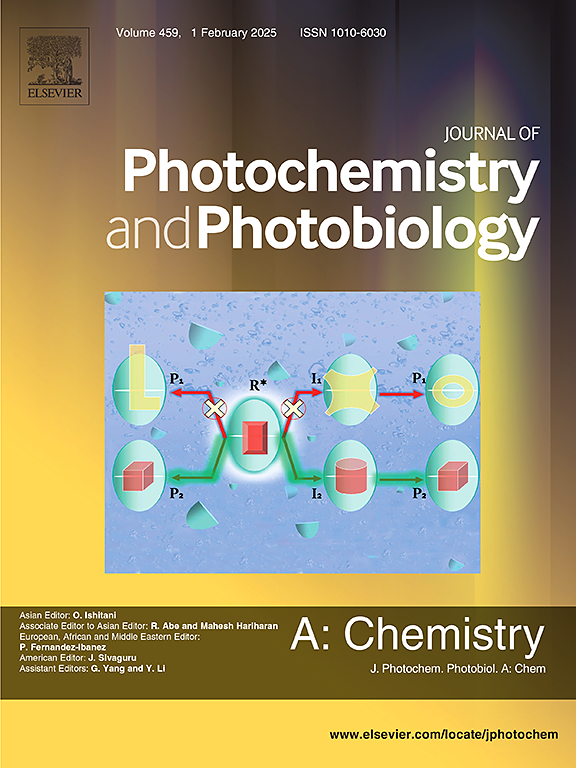新型2,4-二取代喹唑啉的设计、合成及其光物理性质
IF 4.1
3区 化学
Q2 CHEMISTRY, PHYSICAL
Journal of Photochemistry and Photobiology A-chemistry
Pub Date : 2025-03-13
DOI:10.1016/j.jphotochem.2025.116390
引用次数: 0
摘要
通过pd催化4-溴衍生物与芳基硼酸的交叉偶联,合成了一系列2,4-二芳基喹唑啉,其中4-(三氟甲基)苯基、4-氰苯基或4-(甲酰基)苯基在4位上,2位上有一个供电子取代基。还制备了一种具有氰基直接连接到喹唑啉核心的对应物。结果表明,2-(3,4-二甲氧基苯基)喹唑啉和2-(9-乙基- 9h -咔唑-3-基)喹唑啉在甲苯中发光,量子产率高达26%。此外,9-乙基-9 - h -咔唑-3-基取代衍生物在固体状态下的发射效率高达15%。研究了选定的荧光团在不同极性溶剂中的吸收和发射行为,并使用Lippert-Mataga, Bakhshiev和Ravi方程评估了它们的溶剂致色性。吸收光谱与溶剂无关,而发射光谱与溶剂极性显著相关,证实了ICT态的形成。进行了电化学研究和DFT计算来支持实验观察。值得注意的是,合成的甲酰衍生物有望通过与活性亚甲基化合物的缩合反应用于染料敏化太阳能电池材料的开发。本文章由计算机程序翻译,如有差异,请以英文原文为准。

Design, synthesis and photophysical properties of novel 2,4-disubstituted quinazolines
A series of 2,4-diarylquinazolines bearing a 4-(trifluoromethyl)phenyl, 4-cyanophenyl, or 4-(formyl)phenyl group at position 4 and an electron-donating substituent at position 2 were synthesized via Pd-catalyzed cross-coupling of 4-bromo derivatives with arylboronic acids. A counterpart with a cyano group directly attached to the quinazoline core was also prepared. The UV–Vis absorption and photoluminescence properties of dilute solutions of these compounds were investigated, revealing that 2-(3,4-dimethoxyphenyl)quinazolines and 2-(9-ethyl-9H-carbazol-3-yl)quinazolines exhibited emission in toluene with quantum yields of up to 26 %. Furthermore, 9-ethyl-9H-carbazol-3-yl-substituted derivatives demonstrated emission in the solid state with efficiencies up to 15 %. The absorption and emission behavior in solvents with different polarities were examined for selected fluorophores, and their solvatochromism was assessed using the Lippert-Mataga, Bakhshiev, and Ravi equations. While the absorption spectra were solvent-independent, the emission spectra were significantly dependent on solvent polarity, confirming the formation of ICT states. Electrochemical studies and DFT calculations were performed to support the experimental observations. Notably, the synthesized formyl derivatives hold promise for use in the development of materials for dye-sensitized solar cells through condensation reactions with active methylene compounds.
求助全文
通过发布文献求助,成功后即可免费获取论文全文。
去求助
来源期刊
CiteScore
7.90
自引率
7.00%
发文量
580
审稿时长
48 days
期刊介绍:
JPPA publishes the results of fundamental studies on all aspects of chemical phenomena induced by interactions between light and molecules/matter of all kinds.
All systems capable of being described at the molecular or integrated multimolecular level are appropriate for the journal. This includes all molecular chemical species as well as biomolecular, supramolecular, polymer and other macromolecular systems, as well as solid state photochemistry. In addition, the journal publishes studies of semiconductor and other photoactive organic and inorganic materials, photocatalysis (organic, inorganic, supramolecular and superconductor).
The scope includes condensed and gas phase photochemistry, as well as synchrotron radiation chemistry. A broad range of processes and techniques in photochemistry are covered such as light induced energy, electron and proton transfer; nonlinear photochemical behavior; mechanistic investigation of photochemical reactions and identification of the products of photochemical reactions; quantum yield determinations and measurements of rate constants for primary and secondary photochemical processes; steady-state and time-resolved emission, ultrafast spectroscopic methods, single molecule spectroscopy, time resolved X-ray diffraction, luminescence microscopy, and scattering spectroscopy applied to photochemistry. Papers in emerging and applied areas such as luminescent sensors, electroluminescence, solar energy conversion, atmospheric photochemistry, environmental remediation, and related photocatalytic chemistry are also welcome.

 求助内容:
求助内容: 应助结果提醒方式:
应助结果提醒方式:


